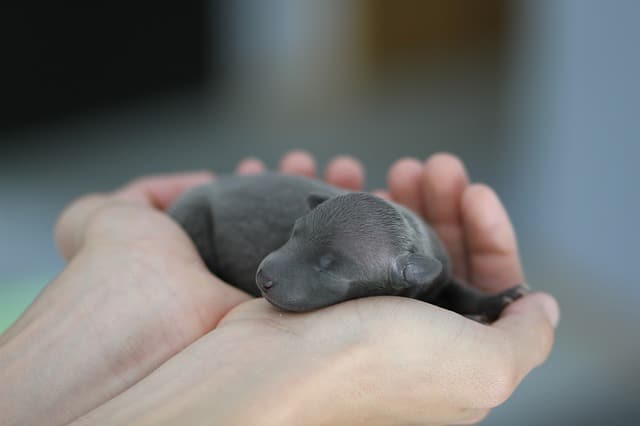The Exception

Although most dogs give birth to littermates within 45 minutes to four hours, there are a few exceptions.
You have probably come across pet parents who claim that their dog gave birth to puppies 1-2 days apart.
A huge majority of the puppies were already dead by the time they were delivered simply because they couldn’t survive without mum’s supply of nutrients and oxygen.
However, some people were shocked to find another live puppy one or two days after the dam started the delivery process.
The only way to explain this is that the placenta remained intact during whelping.
As a result, the dam could still supply oxygen and nutrients through the umbilical vessels of each puppy thereby keeping them sustained.
If the placenta comes loose and the pup remains in the uterus too long, it will certainly die.
However, if (for some miracle) the placenta isn’t tampered with, puppies will survive a while longer.
Please note that this is a very rare exception and happens in a tiny percentage of dogs.
So, Can Puppies Be Born Days Apart?

According to PetMD, puppies are born 45-60 minutes apart.
However, it is not unusual for the dam to take a long break of up to four hours between puppies. This is true if she has a big litter.
The birthing process is exhausting for the poor dog. Often, she will give birth to the first set of puppies pretty quickly before taking a long break to recharge.
Once she feels she can push some more, she will birth the remaining puppies.
It is thus safe to say that it takes anywhere from 45 minutes to four hours between birthing breaks. This means that puppies cannot be born days apart.
During birth, the dam loses the ability to support live puppies inside of her for a day. This is because the placenta, water sac, and other stuff used to support life in the uterus are interrupted. If a puppy stays in for a day or more, she may die.
Ideally, the entire birthing process should not go for more than 24 hours.
Anything beyond 24 hours should be an emergency case and the dam will require a C-section to get her puppies out.
If nothing is done, the poor puppies may not live to see another day.
If dead puppies remain in the uterus for too long, the dam may also lose her life to infections.
Related Posts:
How Many Puppies Can a Dog Have?
The average litter size varies widely depending on the breed.
Larger breed dogs typically have larger litters. The average number of puppies in a litter is six to eight, but some large breed dogs have been known to give birth to many, many more!
Smaller breeds may have two to five puppies. Dogs that only have one or two puppies may not go into labor on their own and may require a c-section. Singleton pregnancies and dog breeds that do not give birth naturally should have a planned c-section discussed with your veterinarian.
Your veterinarian can take an x-ray in the last week of pregnancy to count how many puppies your dog is expecting. This clarity can help pet parents to prepare adequate supplies and expectations.
Puppies are born with a protective fetal membrane that the mother usually removes shortly after birth.
If she does not remove this sac, you must manually remove it to stimulate the puppy to breathe. Break the sac, wipe away fluid from the puppy’s nostrils, open the mouth with the head facing down and wipe off any remaining fluids. Next, stimulate the puppy to breathe by stroking its body firmly with a towel.
If the umbilical cord is not cut during birth or by the mother, you may need to cut it, but be careful not to pull on the cord, as this may cause damage to the puppy’s organs. Instead, break it about an inch or two from the puppy’s body, tearing it gently with your first two fingers and thumb. You may also want to purchase medical instruments, such as clamps and scissors, before the birth to assist in the process.
Here are some things to expect and what to watch for following the birth of the puppies.
Vaginal discharge may last in small amounts for up to eight weeks after the puppies are born. The discharge will normally appear reddish-black since it consists mainly of old blood.
If the discharge is overly bloody, has an odor, or looks like pus, your dog should be examined by her veterinarian as soon as possible. If the discharge slows down but suddenly becomes worse, this could also be a sign to have her examined.
Continue taking your dogs temperature after whelping, as infections after birth are common. If her temperature is over 102.5 or if she is acting sick, contact your veterinarian.
Metritis, or inflammation of the uterus, can occur when a placenta is retained or some trauma occurs during delivery. Contact your veterinarian immediately if you see signs of fever, lack of appetite, odorous vaginal discharge, lack of interest in the puppies, or lack of milk production.